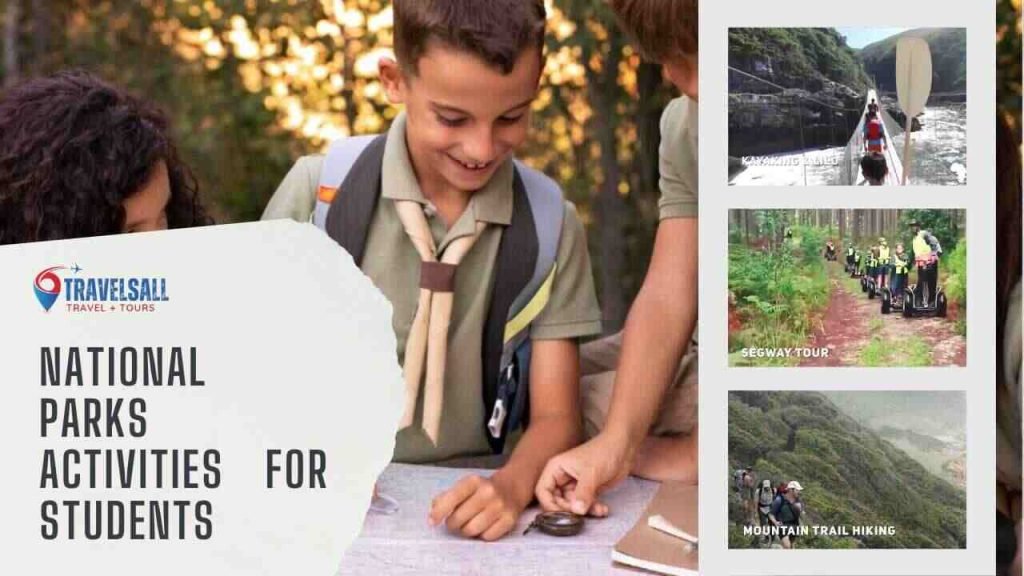National Parks Activities for Students, National Parks offer educational hikes and wildlife observation for students. Interactive programs engage young learners in environmental conservation.
National parks are outdoor classrooms offering diverse educational activities that foster nature appreciation.
Students can join ranger-led hikes exploring diverse terrains, from mountain peaks to lush forests, unveiling ecology wonders.
A rich array of wildlife, from birds to bears, becomes part of a live curriculum. where each sighting is an opportunity to learn about species behavior and habitat conservation.
These parks also often include interactive exhibits and workshops designed to bring lessons to life. illustrating topics like climate change, biodiversity, and cultural history.
Access to such unparalleled, hands-on environmental education is essential for cultivating future generations of conservationists and nature enthusiasts.
Table of Contents
ToggleThe Lure Of National Parks

National Parks are not just expanses of wilderness. They are treasure troves for curious minds.
Exploring a National Park is akin to a vast outdoor classroom, where trails teach and lookouts offer fresh perspectives.
Exciting adventures await students of all ages, with the promise of fresh air, unimaginable beauty, and the call of the wild.
Natural Wonders And Learning Landscapes
National Parks showcase Earth’s masterpieces. Mountains touch the sky, while canyons carve the ground. Each park has unique features to explore:
- Geysers – Watch water erupt from the earth at Yellowstone.
- Glaciers – See icy giants at Glacier National Park.
- Red Rocks – Marvel at the formations in Arches National Park.
Students can turn these wonders into their playground, where science and history come alive right before their eyes.
A Fusion Of Recreation And Education
National Parks link fun and learning in the best way. Paddle a canoe to understand physics. Identify plants and animals to become a young biologist. Check out:
| Activity | Educational Twist |
|---|---|
| Hiking trails | Study geology |
| Stargazing | Learn about constellations |
| Junior Ranger Programs | Participate in conservation |
Every activity combines excitement with knowledge. Whether it’s a history quest or a nature walk, students gain insights while engaged in the fun.
Becoming Junior Rangers
Becoming a Junior Ranger is an adventure into the heart of our national parks. It’s an exciting way for students to learn about nature and history.
This program offers hands-on experiences and challenges. Students explore park secrets, protect the environment, and discover wildlife.
It’s all about fun, education, and stewardship. Let’s dig into how young explorers can start this thrilling journey.
Exploring Ranger-led Programs
Ever wonder what park rangers do? Ranger-led programs give students a sneak peek. These programs are special tours and activities.
Kids can ask Rangers questions and see what they do every day. Programs vary by park and can include:
- Guided nature walks to see plants and animals up close.
- History talks to learn secrets from the past.
- Science demonstrations show amazing natural phenomena.
- Star-gazing evenings for a look at the night sky.
Exciting, right? Check the park’s visitor center or website for schedules.
Earning Badges And Certificates
As part of the Junior Ranger program, students can earn badges and certificates. It’s a proud moment when a ranger presents these awards.
To earn them, students must complete a set of fun and educational tasks, such as:
- Completing activities in the Junior Ranger booklet.
- Exploring different parts of the park.
- Attending ranger-led programs.
- Helping with park conservation efforts.
| Task | Description | Reward |
|---|---|---|
| Activity Completion | Fill out all the pages of your booklet. | Junior Ranger Badge |
| Park Exploration | Visit various park landmarks. | Exploration Certificate |
| Ranger Program Attendance | Join in on ranger-led events. | Program Pin |
Once tasks are complete, show your booklet to a park ranger. They’ll review your work, and you’ll take the Junior Ranger pledge.
This is your moment of glory! Wear your badge and display your certificate with pride. Now you’re part of the park’s future protectors. Congrats, Junior Ranger!
Wildlife Spotting Expeditions

Prepare for a thrilling journey into the wild with National Parks’ Wildlife Spotting Expeditions. Imagine pointing out a bald eagle soaring through the sky or watching a family of deer grazing in a meadow.
With each park boasting its collection of animals and plants, students have a unique chance to observe nature’s wonders up close.
The Art Of Safe And Respectful Observation
During these expeditions, students learn the importance of wildlife safety and ethics. Observing from afar with binoculars and telephoto lenses reduces stress on animals and ensures safety.
Quietly blending into the surroundings is key. Let animals go about their lives undisturbed for a true observation experience.
- Always stay on marked trails.
- Use whispers if you need to communicate.
- Avoid sudden movements.
- Do not attempt to feed or touch wildlife.
- Leave no trace – take all litter with you.
Notable Species And Habitats
In National Parks, students discover diverse ecosystems. From dense forests to arid deserts, each habitat supports different wildlife.
Parks like Yellowstone feature bison, wolves, and grizzly bears. In Everglades National Park, look for manatees, alligators, and an array of birdlife.
| Park Name | Notable Species | Habitat |
|---|---|---|
| Yellowstone | Bison, Wolves, Bears | Forests, Rivers, Meadows |
| Everglades | Manatees, Alligators, Birds | Wetlands, Mangroves, Marshes |
Exciting field activities include bird watching, tracking animal prints, and identifying different species.
Encounters with these creatures create lifelong memories and inspire a love for conservation.
Remember each species plays a role in its environment, so cherish every spot as a valuable peek into the natural world.
Hands-on History Lessons
Step back in time with hands-on history lessons at National Parks. Young minds can touch, feel, and live the stories of yesteryear. These experiences turn the pages of textbooks into real-life adventures.
Historic Landmarks And Cultural Treasures
Historic landmarks bring the past to life for students. National Parks preserve these treasures meticulously.
See forts, homes, and ancient structures up close. Students can wander the historical paths their forebears walked.
- Forts: Witness military history by exploring preserved forts.
- Historic Homes: Peek into the daily life of historical figures.
- Ancient Ruins: Marvel at the ingenuity of ancient civilizations.
Interactive Storytelling And Reenactments
Imagine history books springing to life. Interactive storytelling dynamically engages students.
Reenactments offer a unique peek into historical events. Kids witness history unfold as actors don dramatic costumes and recreate events.
| Activity | Description |
|---|---|
| Story Circles | Tales of the past are shared by captivating narrators. |
| Mock Trials | Students participate in historical court proceedings. |
| Battle Demonstrations | Witness the tactics and weaponry used in historic battles. |
Geological Wonders And Field Science

Exploring National Parks offers more than just breathtaking views; it’s a hands-on science class beneath the sky! Students can touch the heart of the Earth’s history through its geological mysteries.
From ancient rocks to long-lost fossils, every find tells an exciting story. Eager young minds can help in real-world research.
This is our guide to diving deep into the past while crafting a better future, one discovery at a time.
Rocks, Fossils, And Layers Of The Past
Think of rocks as the Earth’s old diaries. These stones whisper tales from millions of years ago. Watch students’ eyes widen as they hold a piece of history. Let’s break it down:
- Igneous rocks form from cooled magma.
- Sedimentary rocks tell of ancient environments.
- Metamorphic rocks are transformed by heat and pressure.
Fossils freeze life’s moments in time. They show us creatures that once roamed the Earth. The layers of rock and soil, called strata, reveal changes over epochs.
Participating In Citizen Science Projects
Science grows with every curious mind that joins the effort. In citizen science projects, students become part of a bigger team.
They collect data, observe, and even discover new things. It’s real science, made fun and accessible. Here’s what they can do:
- Identify plant species to track climate change.
- Measure water quality in park streams and lakes.
- Monitor wildlife movements and behavior.
These projects often publish findings with the students’ names, sparking a love for science that can last a lifetime. Enjoy the adventure of learning outside the classroom walls!
Outdoor Skills And Survival Workshops
Get ready for adventure and learning in America’s natural classrooms! Our National Parks offer amazing Outdoor Skills and Survival Workshops designed for students.
These workshops are perfect for learning how to stay safe and navigate through the wilderness.
Packed with practical activities, students gain hands-on experience from park experts.
Navigating With Map And Compass
Understanding your surroundings is vital while exploring the great outdoors. Our workshop includes:
- Reading topographic maps to recognize land features
- Finding direction without modern tech
- Marking waypoints and plotting courses
You’ll be a pro at map reading and using a compass after this!
Essential Survival Tips For The Wilderness
Survival skills can make a big difference in unexpected situations. Key lessons include:
- Building shelters with natural materials
- Safe water sourcing and purification methods
- Fire-making techniques without matches
Students learn crucial skills to stay warm, hydrated, and safe. These abilities build confidence for any outdoor venture.
Environmental Stewardship And Volunteering
Students can help our National Parks thrive by learning about Environmental Stewardship and Volunteering.
These activities teach kids to take care of nature. Parks offer fun ways to do this. Kids can keep parks beautiful and learn at the same time.
Park Maintenance And Conservation Efforts
National Parks always need extra hands to stay clean and green. Students can join park rangers to learn about planting trees and protecting wildlife.
They can even help fix trails and signs. This helps parks stay welcoming for all visitors.
- Picking up litter to keep parks clean
- Helping to repair broken trails
- Planting new trees and native plants
- Building birdhouses to protect local species
Adopt-a-trail And Other Service Projects
‘Adopt-a-Trail’ programs let students care for a park trail. It’s like having a piece of the park to look after.
They will learn how to keep trails safe and clean. Other service projects can include making signs and helping animals.
| Service Projects | Benefits for Parks |
|---|---|
| Adopt-a-Trail | Trails stay in good shape for hikers. |
| Making Informational Signs | Visitors learn about the park and stay safe. |
| Animal Habitat Projects | Provides homes for wildlife, keeping them healthy. |
By joining these activities, students play a big part in keeping National Parks alive. They take home valuable lessons on caring for our earth.
It’s a fun way to give back and protect our natural treasures for the future.
Creative Arts In Nature
Nature serves as the perfect canvas for young minds to explore their creativity. The vast, untouched landscapes of national parks offer endless opportunities for artistic expression.
Students can dig into the world of ‘Creative Arts in Nature’ and unleash their imagination amidst serene beauty.
Photography And Painting En Plein Air
National parks provide the ultimate backdrop for photography. Students can capture the changing light on mountains or the undisturbed wildlife in their natural habitat.
Each photograph tells a unique story and preserves a moment in time.
- Choose a focal point: something that stands out in the landscape.
- Understand the light: Morning and evening light create magic.
- Practice framing: Use nature’s elements to frame your shot.
For those who love to paint, setting up an easel outdoors—known as ‘painting en plein air’—allows students to absorb the environment’s essence.
The changing light and colors challenge artists to work swiftly, capturing the scene before it transforms.
National Parks As Artistic Inspiration

Stunning vistas and diverse wildlife inspire all forms of art. National parks have been muses for poets, writers, and painters for centuries.
Students can draw inspiration from these unspoiled sceneries to create their masterpieces.
| Activity | Benefits |
|---|---|
| Sketching Landscapes | Boosts observation skills and mindfulness. |
| Writing Poetry | Enhances language and emotional expression. |
| Composing Music | Fosters creativity and a connection with nature. |
Connecting with nature catalyzes creativity. With so many different parks to explore, each offers a unique atmosphere to stimulate the artistic process.
Encourage students to take their sketchbooks, canvases, or instruments and find their creative path in the vastness of America’s national parks.
Planning Your Educational Visit
Excitement buzzes in the air as you plan an educational trip to a National Park. It’s a chance for students to explore nature and learn outside of classrooms.
National Parks offer hands-on learning experiences, helping students understand the environment and history. To maximize this opportunity, plan your visit carefully.
Best Practices For School Trips
Start early with your preparations to ensure a smooth educational trip. Book your park visit well in advance. Obtain permission slips and medical forms as needed.
- Organize travel logistics including transportation, routes, and parking.
- Design pre-visit activities to introduce students to topics they’ll explore.
- Contact park rangers for guided tours and educational materials.
- Pack essentials like first aid kits, water, snacks, and sun protection.
- Enforce a buddy system to maintain student safety at all times.
Grants And Resources For Educators
Financial assistance can make National Park trips accessible and enriching. Look for funding opportunities designed for educational visits.
| Grant/Resource | Description | How to Apply |
|---|---|---|
| National Park Foundation | Offers ticket grants for educational groups. | Visit their website to submit an application form. |
| Every Kid Outdoors | Provides free park entry for 4th-grade students. | Get a pass online by participating in an educational activity. |
| Target Field Trip Grants | Helps cover transportation and admission costs. | Apply online during the open period. |
Explore online platforms for lesson plans and educational kits. The National Park Service’s Teachers section is a great start. From interactive guides to curriculum materials, it’s a treasure trove for educators.
Frequently Asked Questions On National Parks Activities For Students
What Activities Can People Do When Visiting The National Park?
Visitors can hike trails, observe wildlife, go camping, and enjoy scenic drives in national parks. Photography, educational programs, and picnicking are also popular activities.
How Do You Explain National Parks To Kids?
National parks are special places protected by the government where nature, animals, and plants can live safely and people can enjoy them.
What Do National Parks Teach?
National parks teach about biodiversity, conservation efforts, and natural history. They offer insights into wildlife habitats and environmental stewardship. Visitors learn the importance of preserving natural spaces for future generations.
Why Are National Parks Fun?
National parks offer diverse wildlife, breathtaking landscapes, and numerous outdoor activities, making them great for adventure and relaxation.
Conclusion
Exploring national parks offers students a treasure trove of experiences. They stretch their learning beyond classrooms into nature’s vast classroom.
Encouraging young minds to partake in park activities fosters a love for the environment and sparks curiosity. Let’s gear up for outdoor education that’s both fun and enriching.
Adventure awaits in every national park visit!



